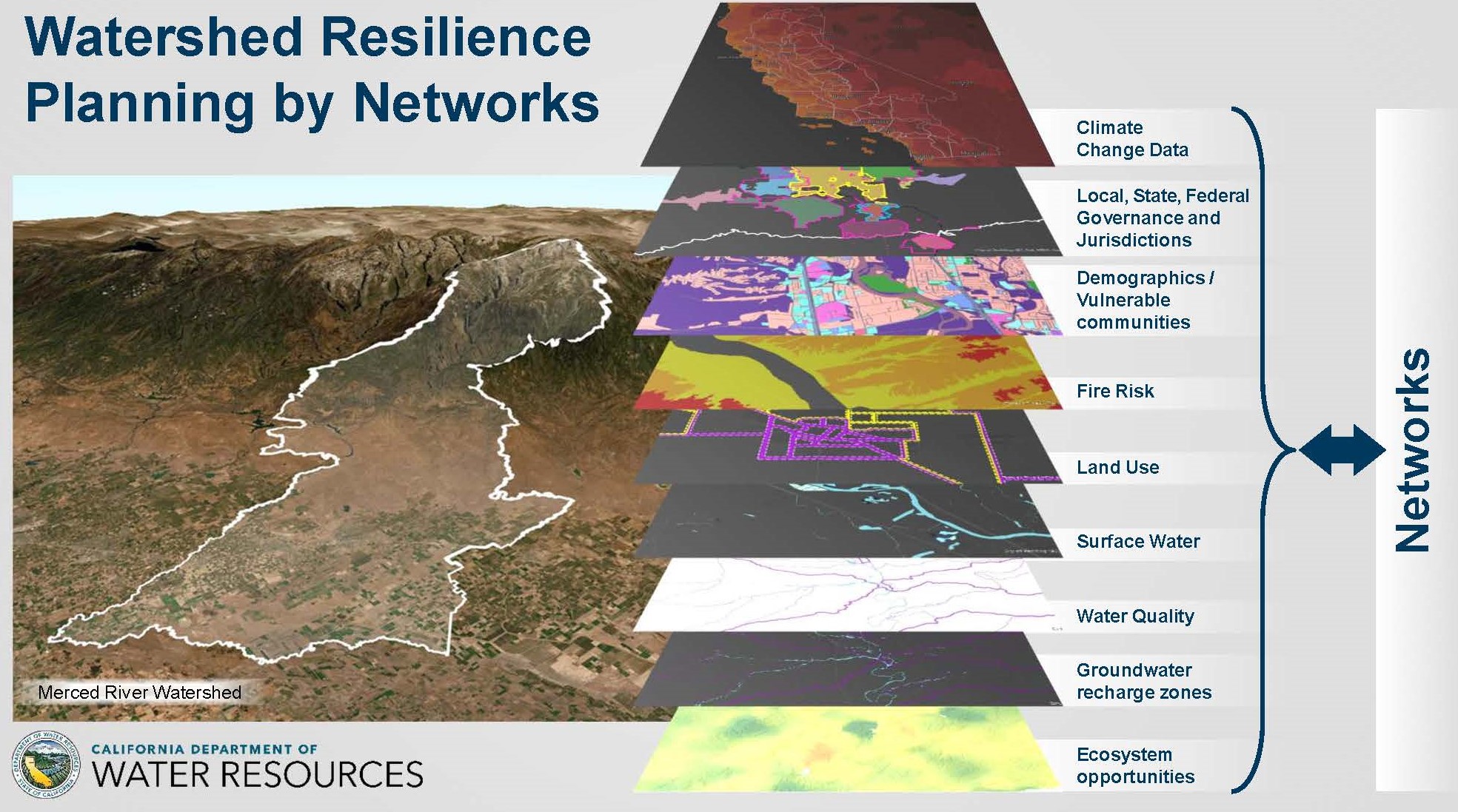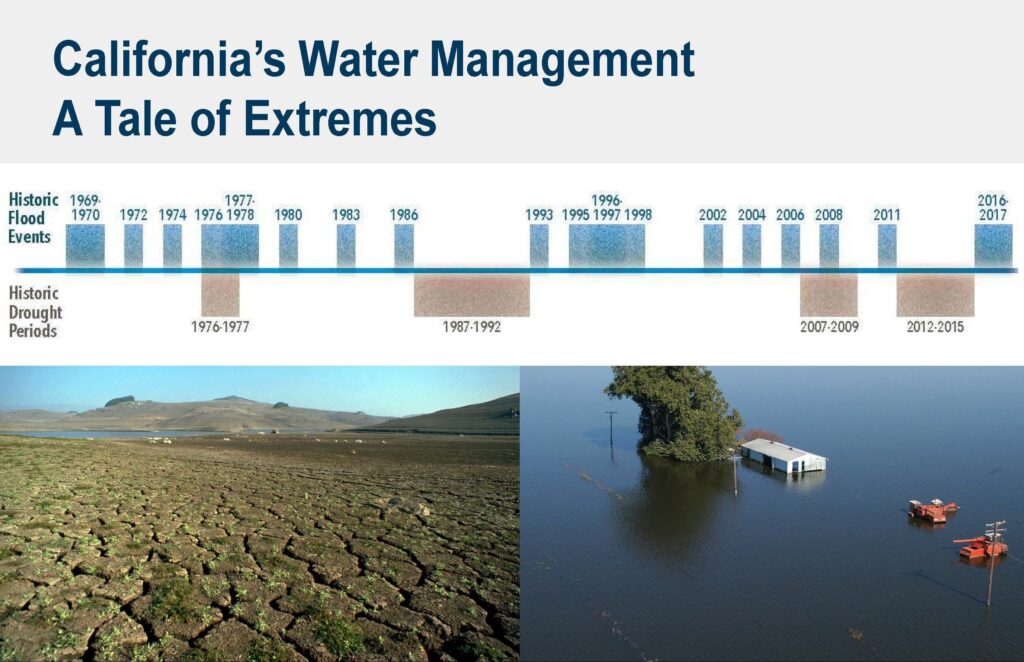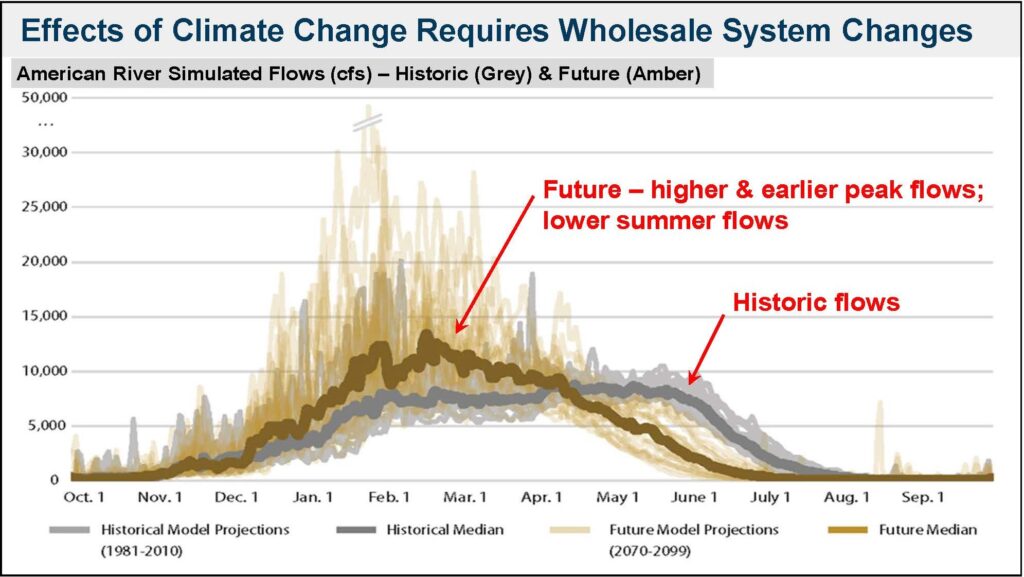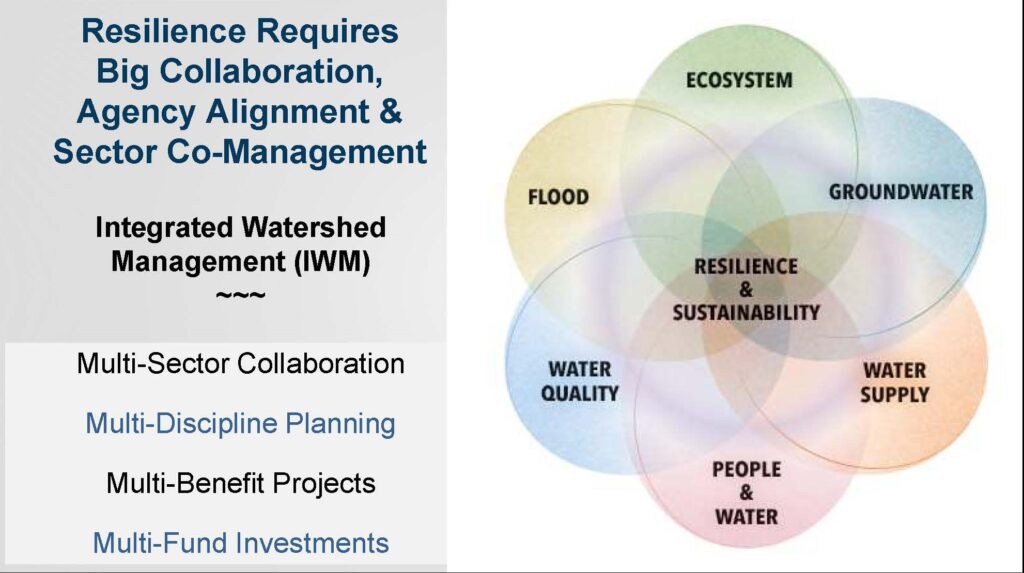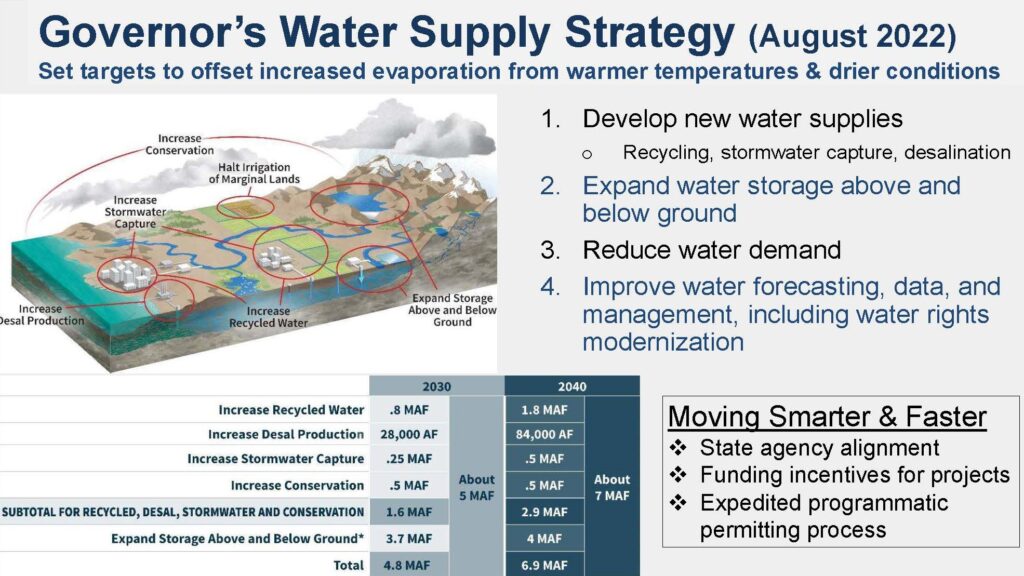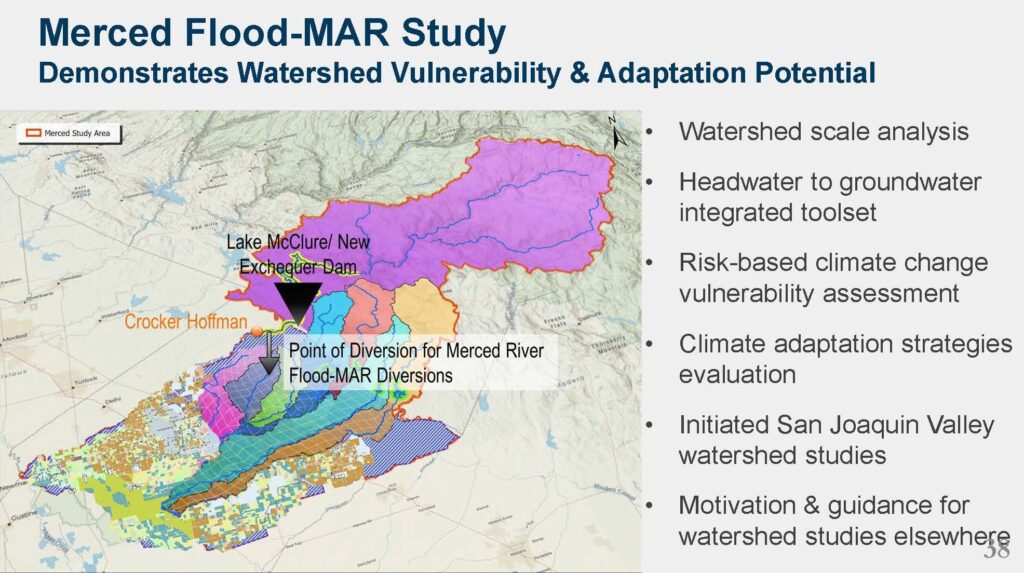Kamyar Guivetchi is the Manager of DWR’s Division of Planning, where he works with staff, numerous government agencies, California Native American tribes, other stakeholders, and the public to prepare the California Water plan updates. At the UC Davis Groundwater SAS Symposium, Mr. Guivetchi gave a keynote address focusing on the need to build watershed resilience by increasing integration among agencies with responsibilities for water resources. He also touched on the Newsom administration’s water initiatives, the update to the California Water Plan, and Flood-MAR.
Mr. Guivetchi began by noting that context is really important when discussing water in California. California is a big state with ten hydrologic regions, each the size of other states.
“If California were the size of Connecticut, we would have an entirely different way of thinking about water,” he said. “So the size and diversity of our hydrologic regions mean there are no cookie-cutter solutions. We really have to work at the watershed scale and customize what needs to be done.”
California water has a Mediterranean climate. The state rarely gets average water conditions; it’s usually one extreme or the other. On the graph below, the blue bars show flood events, and the brown bars are droughts. In some years, there can be a flood and a drought in the same year, although not necessarily occurring in the same region.
The figure on the slide below shows how climate change alters runoff patterns. The graph shows historic and model data for the American River; the historical record from 1980 to 2010 is shown in gray, and the amber colors show projections for 2070 to 2100.
“There is a noticeable shift in the runoff,” said Mr. Guivetchi. “It’s notable partly because, in the summer months, we’ll likely have less runoff. And in the winter months, we will have more flashy runoff. Over the last 100-120 years, we have designed, built, and operated our systems to the historic hydrology, but that will not work for us in the future. So we’ll have to rethink, remodernize, and reoperate our system.”
The wicked problem: Changing people
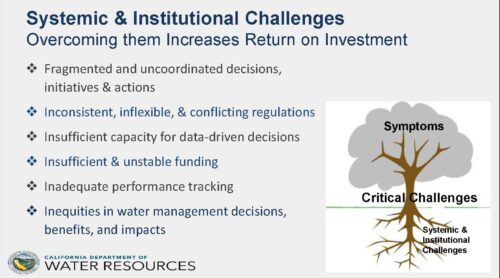 California has plenty of systemic and institutional challenges, but Mr. Guivetchi said people are really the ‘wicked problem.’
California has plenty of systemic and institutional challenges, but Mr. Guivetchi said people are really the ‘wicked problem.’
“Changing people’s behavior is as or much harder than implementing science and technology,” he said. “We have over 2300 entities in California that manage some aspect of the water cycle. We have many of those entities setting regulations for different sectors of the water cycle and water management. And when you put them together and ask a project proponent to get the permits they need, they pull their hair out. It’s very complex, and sometimes they get pulled in different directions.”
Data is as siloed as the people are, which makes accessing, synthesizing, and analyzing it. Funding is a constant challenge, but because people work in their silos, they don’t pool together available funds and sometimes duplicate efforts.
“We have to do a better job of showing the return on investment, particularly for public funding,” said Mr. Guivetchi. “The public, the legislators, and the governor want to know that the money we’ve received and invested is actually making a difference. But unfortunately, we don’t monitor or measure the kinds of indicators that are needed to do that. I can tell you how much money we spent, how many projects and which projects we completed. But whether they made a difference – that’s a harder thing to demonstrate.”
The flower diagram on the slide below illustrates the major water sectors that manage water in California. And underneath the petals are the land use sectors. Historically, and even today, folks tend to operate on the periphery of the petals with little or no overlap. As a result, each sector is good at optimizing for its sector, sometimes to the detriment of other sectors.
“So to be resilient and sustainable, we have to get our water sectors to work toward the center of this flower where there’s more overlap,” he said. “We have to learn to do multi-sector optimization. And that’s what we mean by integrated watershed management. It means bringing the sectors together; it means bringing disciplines together to design multi-benefit projects and bring their pots of money with them so that we can implement those projects.”
Newsom water initiatives
 In 2020, the Newsom administration released the Water Resilience Portfolio, which is the blueprint for state agencies that set priorities for water management. The portfolio was developed jointly by the Natural Resources Agency, Cal EPA, and the Department of Food and Ag, so it integrates the different programs, projects, and expertise of the agencies and their respective departments to achieve the objectives.
In 2020, the Newsom administration released the Water Resilience Portfolio, which is the blueprint for state agencies that set priorities for water management. The portfolio was developed jointly by the Natural Resources Agency, Cal EPA, and the Department of Food and Ag, so it integrates the different programs, projects, and expertise of the agencies and their respective departments to achieve the objectives.
“So if you’re thinking about how to communicate with the administration about the work you’re doing, or how you can potentially get funding and collaboration, this will help you speak the language they are accustomed to hearing,” said Mr. Guivetchi.
The principles of the Water Resilience Portfolio:
- Prioritize multi-benefit approaches that meet multiple needs at once
- Utilize natural infrastructures such as forests and floodplains
- Embrace innovation and new technologies
- Encourage regional approaches in watersheds
- Incorporate successful approaches from other parts of the world
- Integrate investments, policies, and programs across state government
- Strengthen partnerships with local, federal, and tribal governments, water agencies and irrigation districts, and other stakeholders
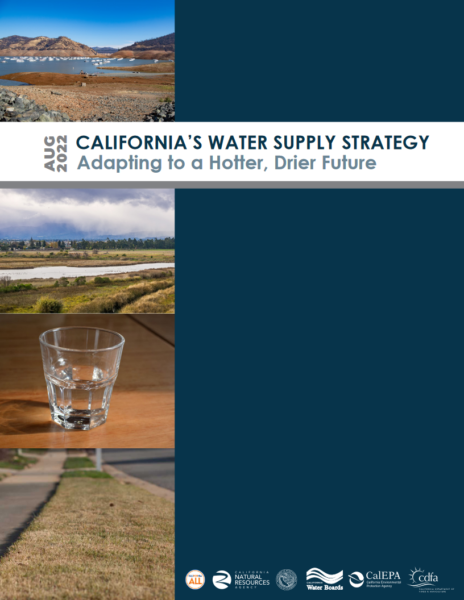 In August, the Newsom administration released the Water Supply Strategy. It is about 15 pages long and is considered a subset of the Water Resilience Portfolio. It was developed after the observation that during the last drought, there was less runoff from precipitation events. Mr. Guivetchi explained that this is because the hotter, drier conditions are sucking the moisture out of the topsoil, so when there is precipitation, some is absorbed by the soil before running off as surface water. As a result, it is estimated that there will be about 10% less surface runoff in the next couple of decades than historically. So the Water Supply Strategy sets targets for water conservation, water recycling, ocean, and brackish desalination, urban stormwater capture, and using floodwaters to recharge groundwater aquifers.
In August, the Newsom administration released the Water Supply Strategy. It is about 15 pages long and is considered a subset of the Water Resilience Portfolio. It was developed after the observation that during the last drought, there was less runoff from precipitation events. Mr. Guivetchi explained that this is because the hotter, drier conditions are sucking the moisture out of the topsoil, so when there is precipitation, some is absorbed by the soil before running off as surface water. As a result, it is estimated that there will be about 10% less surface runoff in the next couple of decades than historically. So the Water Supply Strategy sets targets for water conservation, water recycling, ocean, and brackish desalination, urban stormwater capture, and using floodwaters to recharge groundwater aquifers.
The strategy recognizes the need to better forecast atmospheric rivers, which provide most of the state’s water, and for water data to be more accessible. In addition, it notes the need to modernize the water rights system. The strategy also calls for agencies to align programs, provide joint funding incentives to meet the targets, and expedite permitting processes.
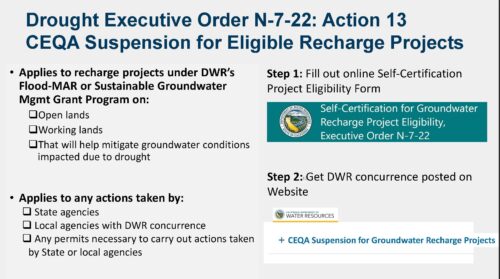 In April, The Governor issued an executive order for the drought covering water conservation and well drilling and for urban water agencies to implement their water shortage contingency plans. It also covered several aspects of groundwater recharge and, for the first time, called out flood managed aquifer recharge as a strategy to invest in. The executive order also set up a process for certain eligible projects can waive CEQA to get a temporary water rights permit that could be used to prepare to use floodwaters to recharge groundwater, particularly on ag and working lands.
In April, The Governor issued an executive order for the drought covering water conservation and well drilling and for urban water agencies to implement their water shortage contingency plans. It also covered several aspects of groundwater recharge and, for the first time, called out flood managed aquifer recharge as a strategy to invest in. The executive order also set up a process for certain eligible projects can waive CEQA to get a temporary water rights permit that could be used to prepare to use floodwaters to recharge groundwater, particularly on ag and working lands.
California Water Plan
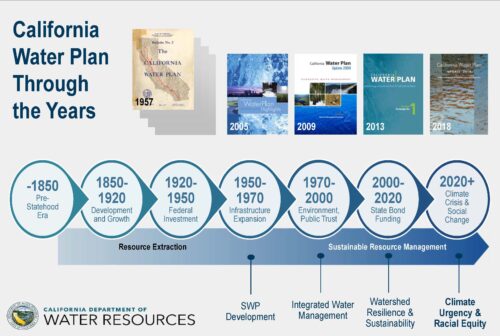 The water code directs the Department of Water Resources to update the California Water Plan every five years. The first plan was completed in 1957; since then, it’s been updated 12 times. DWR is currently working on the 2023 update.
The water code directs the Department of Water Resources to update the California Water Plan every five years. The first plan was completed in 1957; since then, it’s been updated 12 times. DWR is currently working on the 2023 update.
The focus of the California Water Plan has changed over the years. From statehood to the 1970s is considered the extraction period for economic growth and urban development with little consideration of the effect on the environment. Then, in the 1970s, as the recognition of environmental consequences grew, the Clean Water Act, the Endangered Species Act, and other regulatory frameworks were enacted to overcome those consequences.
“We’re now in what I think of as a sustainable resource management phase, and most recently in the climate crisis and social inequity phase, so we really have to work on climate urgency and racial equity,” said Mr. Guivetchi.
Over the last 20 years, Mr. Guivetchi and his team have worked to transform the way the Water Plan is developed. It is now a collaborative process that includes about 30 other state agencies, California Native American tribes, and representatives from communities and others.
“We have begun transforming the water plan from being thought of as DWR’s water supply plan to the state’s Integrated Watershed Management Plan. And what that means is DWR has to bring others in because we do not have the authority or the expertise for all aspects of water, even within our state agency family. So we’ve moved toward this integrated watershed management approach, and we’re moving to manage water for sustainability and resilience. And by sustainability, we mean equity, environment, and economy.”
Mr. Guivetchi is especially proud of the efforts to include California Native American Tribes. They have held three tribal water summits, with a fourth scheduled for April 2023. In addition, the Department has developed a guidance document for engaging with Tribal governments. And the Water Plan effort includes a Tribal Advisory Committee.
“For the first time, we have a standalone chapter, not just about tribes, but written by tribes,” he said. “The Tribal Advisory Committee for the water plan is writing this chapter in their own voice.”
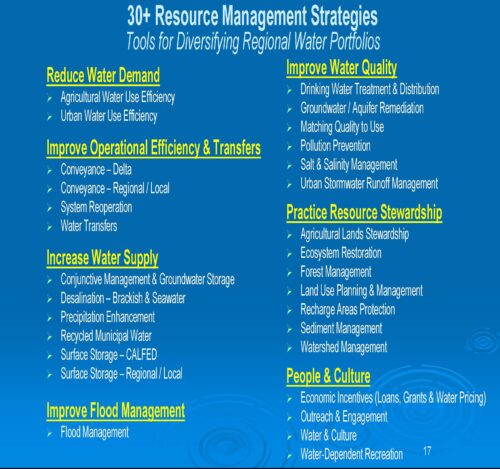 The Water Plan includes a toolbox for integrated watershed management, with over 30 strategies organized by what they are intended to accomplish. The strategies were developed by subject matter experts from multiple agencies with input from local subject matter experts. Each strategy has an article that defines the strategy, determines the level of implementation to date, estimates the potential opportunity and what it might cost, the barriers to implementation, and recommendations to overcome those challenges.
The Water Plan includes a toolbox for integrated watershed management, with over 30 strategies organized by what they are intended to accomplish. The strategies were developed by subject matter experts from multiple agencies with input from local subject matter experts. Each strategy has an article that defines the strategy, determines the level of implementation to date, estimates the potential opportunity and what it might cost, the barriers to implementation, and recommendations to overcome those challenges.
Mr. Guivetchi noted that one of the big challenges is recognizing that land use planning and water management must become more integrated. “Cities and counties do land use planning, and water agencies do the water planning, and historically, they haven’t necessarily worked closely together,” he said. “Integrated regional water management, the GSAs, and regional flood management groups are beginning to improve that connection, but we have to do a lot better job.”
He said that the Water Resilience Portfolio and the Water Supply Strategy are considered cornerstones of the update, and the Governor’s Climate Action Plan and budget are central. With $54 billion in the state budget for climate action, understanding the Water Resilience Portfolio and the intention of the funding can provide opportunities for partnerships and funding.
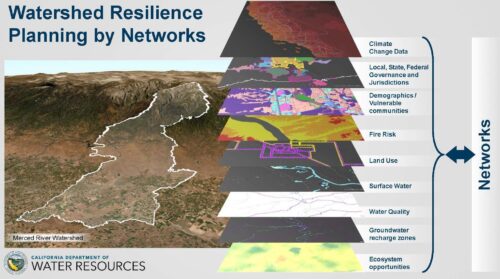 One of the themes of this update to the California Water Plan is watershed resilience. The data layers on the graphic represent the different sectors and institutions that have information about the watershed but haven’t worked together historically.
One of the themes of this update to the California Water Plan is watershed resilience. The data layers on the graphic represent the different sectors and institutions that have information about the watershed but haven’t worked together historically.
“What watershed resilience is advocating is that we have to work from headwater all the way through groundwater,” said Mr. Guivetchi. “You can’t manage groundwater without having all those other pieces. And the way to do that is through networks because IRWM groups don’t want to reform themselves, and neither do GSAs, regional flood groups, and the Water Quality Collaboratives. But what networks allow is that each one can keep their identity but agree on how they will work together toward a common purpose.”
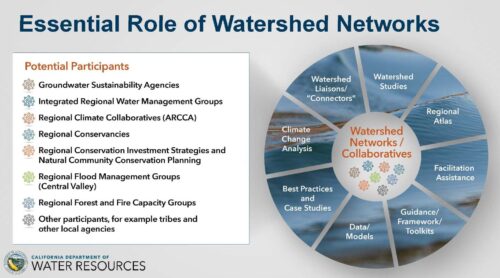 “So watershed networks are the hub of making watershed resilience work,” he continued. “This is, in my mind, the tough stuff, but we have to do it if we’re going to have a chance of getting in front of the vulnerability from climate change because one of the things we’re learning is that all sectors are vulnerable to climate change impacts – not in the same way, but they’re all very vulnerable. And they will depend on each other to overcome those vulnerabilities.”
“So watershed networks are the hub of making watershed resilience work,” he continued. “This is, in my mind, the tough stuff, but we have to do it if we’re going to have a chance of getting in front of the vulnerability from climate change because one of the things we’re learning is that all sectors are vulnerable to climate change impacts – not in the same way, but they’re all very vulnerable. And they will depend on each other to overcome those vulnerabilities.”
The update will have eight chapters, with a public draft by the end of next March and a final plan by December 2023. The fourth Tribal Summit is scheduled for April 2023.
Learn more about the California Water Plan at this link, and subscribe to the Water Plan eNews for weekly updates.
Flood Managed Aquifer Recharge (Flood MAR)
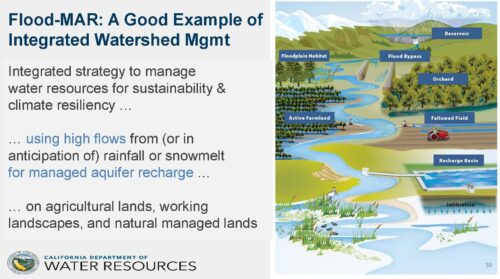 Flood MAR is a multi-sector, multi-agency approach to being resilient and sustainable; it requires big collaboration, agency alignment, and comanaging at the watershed scale from headwater to groundwater.
Flood MAR is a multi-sector, multi-agency approach to being resilient and sustainable; it requires big collaboration, agency alignment, and comanaging at the watershed scale from headwater to groundwater.
Flood MAR is an approach to use high flows to recharge depleted aquifers. The program is voluntary, where private landowners and the public sector work together. It’s multi-sector and scalable. It’s been implemented by Don Cameron, president of the State Board of Food and Ag, and others at the farm scale, but it can be done at the watershed scale.
“And it’s multifaceted,” pointed out Mr. Guivetchi. “There’s not just one type of Flood MAR project. It’s really an approach that’s an untapped part of our water portfolio.”
The Flood MAR approach begins at the headwaters, where improved forest management and meadow restoration help retain the flashy runoff above the reservoirs. Also, Forecast Informed Reservoir Operations takes advantage of improved forecasting of atmospheric rivers, allowing reservoir operators to draw down the reservoir in advance. With better conveyance, that water can be moved onto ag and working lands, providing habitat for birds and terrestrial species and recharging the aquifers. As the water table in the aquifers rise, they reconnect with their adjacent streams and provide better fish habitat.
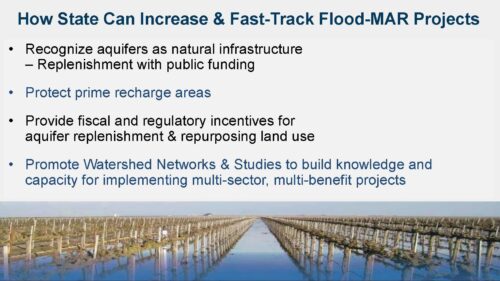 The good news is that California has begun recognizing Flood MAR as an important strategy, but Mr. Guivetchi cautioned that it is not a silver bullet. “Remember, no strategy works everywhere in California or as effectively, but it is an important piece,” he said.
The good news is that California has begun recognizing Flood MAR as an important strategy, but Mr. Guivetchi cautioned that it is not a silver bullet. “Remember, no strategy works everywhere in California or as effectively, but it is an important piece,” he said.
The state’s policy needs to be updated to recognize aquifers as natural green infrastructure. “Nowhere in the resource code will you see that,” he said. “You’ll see it for forests, you’ll see it for floodplains, you’ll see it for riverine habitat, so we as a state have to recognize aquifers as natural green infrastructure. Why? Because that can open public funding for replenishing these degraded aquifers.”
It’s also important to protect recharge areas. Mr. Guivetchi noted that as farmers work to meet the requirements of SGMA, they may have to repurpose some of their lands. “Let’s make sure that some of that is dedicated groundwater recharge basins,” he said. “Creating markets that are public-private can help us do that. So in looking for multi-benefit recharge projects, how about environmental water accounts under the ground? How about the US Fish and Wildlife Service, NOAA, or Department of Fish and Wildlife paying landowners to take floodwaters into their aquifer so that during the next dry period, they use that groundwater and leave the water in the channel for the fish?”
“How about repurposing land use, so we keep landowners on the land? Let’s not talk about land retirement or fallowing; let’s talk about land repurposing for crop rotation, healthy soils, dedicated recharge basins, creating restoration, and solar farms. How about solar farms that you do recharge underneath?”
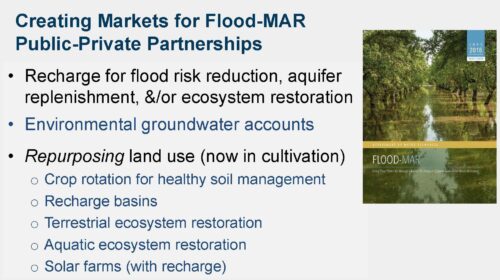 The Department of Water Resources has been working on Flood MAR since 2016. A white paper has been written, and a research and data plan has been developed. The Department is also working on watershed studies in the Merced and the San Joaquin and partnering on several pilot projects in the San Joaquin basin. In addition, a Flood MAR network has been created to share data and information.
The Department of Water Resources has been working on Flood MAR since 2016. A white paper has been written, and a research and data plan has been developed. The Department is also working on watershed studies in the Merced and the San Joaquin and partnering on several pilot projects in the San Joaquin basin. In addition, a Flood MAR network has been created to share data and information.
“The research advisory committee had 13 different subcommittees, and they came up with 130 research information gaps and recommended their top three, so if you’re looking for projects, the state has said these are important to the state. So I think it’s kind of a treasure trove of projects. And you can see how diverse those disciplines are, so something for most anyone.”
Learn more about Flood-MAR here.
Merced Watershed Study
The Department has completed a comprehensive watershed study for the Merced River from the headwaters to the groundwater basin. It utilized 30 different climate scenarios, which enabled a risk-based analysis that considers the probabilities of occurrence of conditions under flood. In addition, the study analyzed several climate adaptation strategies, Flood MAR, forecast-informed reservoir operations, and more aggressive system reoperation.
“For one of those 30 climate scenarios, a three-degree increase in temperature and a 10% increase in precipitation, the Merced River peak flood conditions were 600% what they were historically,” said Mr. Guivetchi. “There was a 20% increase in groundwater overdraft and 9% fewer months where conditions were conducive to groundwater-dependent ecosystems. Lake McClure at the end of the irrigation season was 9% lower, and there was a 7% increase in agricultural water demand because of those high temperatures.”
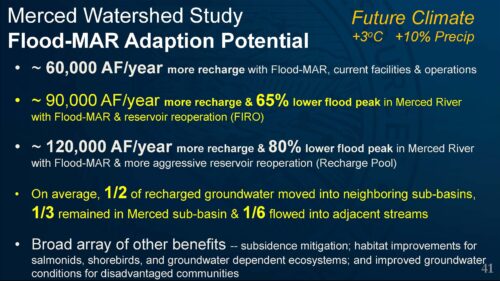 “But this wasn’t just a doom and gloom study,” he continued. “It looks like a six to seven-fold increase in flood peaks. The Merced River today can manage 6000 CFS; there’s no way it can manage 42,000. Okay, huge flood risk. And so, when we ran those adaptation studies, we showed that by using Flood MAR, forecast-informed reservoir operation, and more aggressive system reoperation, we were able to increase groundwater recharge by 120,000 acre-feet per year. And over the 100-year simulation that we ran, that’s 12 million acre-feet of water – that’s just the flood peak water, and that 42,000 peak flood came down to 8500. So it’s a lot easier to build our way to 8500 from 6000.”
“But this wasn’t just a doom and gloom study,” he continued. “It looks like a six to seven-fold increase in flood peaks. The Merced River today can manage 6000 CFS; there’s no way it can manage 42,000. Okay, huge flood risk. And so, when we ran those adaptation studies, we showed that by using Flood MAR, forecast-informed reservoir operation, and more aggressive system reoperation, we were able to increase groundwater recharge by 120,000 acre-feet per year. And over the 100-year simulation that we ran, that’s 12 million acre-feet of water – that’s just the flood peak water, and that 42,000 peak flood came down to 8500. So it’s a lot easier to build our way to 8500 from 6000.”
“Also, half of the recharge water went to neighboring aquifers, a third stayed in the Merced basin, and a sixth went to those adjacent channels,” he said. “This was noteworthy enough that we received funding to do the same study for all the tributaries of the San Joaquin Valley. And if I had my way, we get that funding, not just for DWR but working with our local partners, to do this across the Central Valley and Central Coast and other places where groundwater is important.”


